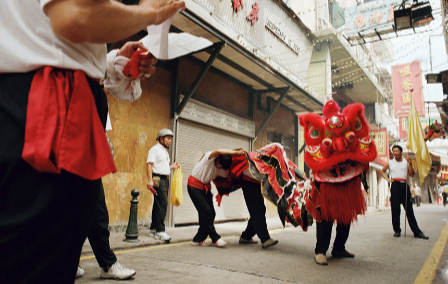Published 1st Feb. 2022
Reading time
To the 80% of the planet's population that aren't Chinese, the celebration practices of Chinese New Year are still shrouded in relative mystery, save for abstract flashes of association: the colour red! Dancing dragons! Paper lanterns! Thus, we shed light on how some of China's big cities celebrate the Spring Festival, as it's also known.
New Year's celebrations date back hundreds of years in China's capital, Beijing, which is buzzing at this time of year. At midnight on the 30th, there's an enormous fireworks display which is unparalleled by Western efforts. The fireworks continue on and off for 15 days - no big deal; just be sure to pack ear plugs. The evening ends as all good evenings should, with traditional dumpling eating to signify prosperity. It's on New Year's Day that residents start to make the rounds, visiting relatives armed with the famed hong bao - red envelopes containing money, to non-Mandarin speakers. If you're visiting Beijing over the Spring Festival (as Chinese New Year is also known), make a beeline for a temple fair: they're a great showcase of Chinese culture, folk art, and - most importantly - the fabled dragon and lion dances. You'll catch all of the above, as well as reenactments of the Qing Dynasty's worship ceremonies, at the Ditan Temple Fair - but if you're after a more authentic experience, head to the Hongluo Temple Fair.
New Year's celebrations are wonderfully varied in Hong Kong. There's an annual flower market, which opens around ten days before New Year and closes in the early morning of New Year's Day; a parade with floats; and various sporting events, from the Chinese New Year Race Day (a popular horse race) to the Lunar New Year Cup (a football tournament). One of our favourite traditions happens on the eve of the big day: worshippers wait outside Wong Tai Sin Temple (a famous tourist spot) and rush inside once New Year begins, hoping to be the first to offer incense to Wong Tai Sin, a deity with healing powers.
Harbin has become renowned solely for the eponymous Harbin International Ice and Snow Sculpture Festival, which officially opens on the 5th of January. As the name suggests, ice and snow carvings are the main attraction here: imagine whole cities of life-sized luminous ice palaces and great monoliths of sculpted powder, and you'll begin to get the picture. A little like Legoland, if it were made out of winter weather.
The largest city by population in China, New Year is probably the only time in Shanghai that you'll be able to enjoy relative peace and quiet, as most of it's inhabitants - and, subsequently, it's infrastructure - grinds to a halt. Never fear: it doesn't mean that celebrations get sidelined. The Lantern Festival on the 14th of February is a particularly pretty tradition that this year sees Shanghai's Yu Garden illuminated and adorned with special horse and dragon lanterns.

Our team has been visiting China since the ‘90s, exploring all corners of the country from bustling Beijing to traditional Tibet. This in-house knowledge is brought to life by our guides, who’ll take you to places few tourists have heard of, including gems like the Mogao Caves in the Silk Road town of Dunhuang. Craving exceptional Chinese cuisine? Our Concierges are just a WhatsApp away, ready to book you into exclusive restaurants (on top of securing special access to curator-led museums and more). For a culture-packed adventure from the Guangxi mountains in the south to the Xinjiang deserts in the north, leave the planning to us.
ENQUIRE NOWPractical advice and inspiration for your next trip

Despite its wonderful reputation among walkers, Himalayan holidays aren’t reserved for those who enjoy a hearty hike. Slicing its way through six countries, this mountain range is home to rich cultures that don’t require walking boots to be explored. From ancient temples in Tibet to Buddhism in Bhutan, spirituality and culture in the Himalayas are carved into the landscape itself. Leave hiking behind and read on to discover where to find some of the region’s richest cultural and spiritual experiences.
15th November 2024 - China Culture

China is a fascinating country in which to travel. However, I am not going to lie and say it will ever be my favourite destination; it is a tough country to travel in. There were times that I absolutely loved it and others when I was wondering what on earth I was doing there. However, I do think it is somewhere that everyone should travel to at least once. As one of the world's largest countries, it isn't somewhere that you can see all in one trip, but you should go soon as some of the history and culture is being lost to Western modernisation.
28th June 2021 - China Travel Inspiration

To the 80% of the planet's population that aren't Chinese, the celebration practices of Chinese New Year are still shrouded in relative mystery, save for abstract flashes of association: the colour red! Dancing dragons! Paper lanterns! Thus, we shed light on how some of China's big cities celebrate the Spring Festival, as it's also known. Beijing New Year's celebrations date back hundreds of years in China's capital, Beijing, which is buzzing at this time of year.
1st February 2022 - China Culture

Our team of destination experts will get to know you and your unique requirements for your holiday

We work with you to build an ultra-personalised holiday itinerary with your choice of accommodation, experiences and activities

All of our holidays include little extras designed to make a big difference to your trip, from fast-tracking you through airport check-in and security to our network of local Concierges